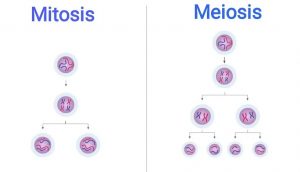
Description
Organisms grow and reproduce through cell division. In eukaryotic cells, the production of new cells occurs as a result of mitosis and meiosis. These two nuclear division processes are similar but distinct. Both processes involve the division of a diploid cell or a cell that contains two sets of chromosomes (one chromosome donated by each parent). A comparison of Meiosis and Mitosis are discussed below.
In mitosis, the genetic material (DNA) of a cell is duplicated and divided equally between two cells. The dividing cell goes through an ordered series of events called the cell cycle. The mitotic cell cycle is initiated by the presence of certain growth factors or other signals that indicate that new cell production is needed. Somatic cells in the body replicate by mitosis. Examples of somatic cells include fat cells, blood cells, skin cells, or any cell in the body that is not a sex cell. Mitosis is necessary to replace dead cells, damaged cells, or cells that have a short lifespan.
Meiosis is the process by which gametes (sex cells) are generated in organisms that reproduce sexually. Gametes are produced in the male and female gonads and contain half the number of chromosomes as the original cell. New combinations of genes are introduced into a population through genetic recombination that occurs during meiosis. Thus, unlike the two genetically identical cells that are produced in mitosis, the meiotic cell cycle produces four cells that are genetically different.
Differences Between Mitosis and Meiosis
1. Cell division
- Mitosis: A somatic cell divides once. Cytokinesis (the division of the cytoplasm) occurs at the end of telophase.
- Meiosis: A reproductive cell divides twice. Cytokinesis occurs at the end of telophase I and telophase II.
2. Secondary cell number
- Mitosis: Two daughter cells are produced. Each cell is diploid and contains the same number of chromosomes.
- Meiosis: Four daughter cells are produced. Each cell is haploid and contains half the number of chromosomes as the original cell.
3. Genetic composition
- Mitosis: The resulting daughter cells in mitosis are genetic clones (they are genetically identical). No recombination or crossover occurs.
- Meiosis: The resulting daughter cells contain different combinations of genes. Genetic recombination occurs as a result of the random segregation of homologous chromosomes in different cells and by the process of crossing over (gene transfer between homologous chromosomes).
4. Duration of prophase
- Mitosis: During the first mitotic stage, known as prophase, chromatin condenses into discrete chromosomes, the nuclear envelope breaks down, and spindle fibres form at opposite poles of the cell. A cell spends less time in the prophase of mitosis than a cell in prophase I of meiosis.
- Meiosis: Prophase I consists of five stages and lasts longer than the prophase of mitosis. The five stages of meiotic prophase I are leptotene, zygotene, pachytene, diplotene, and diakinesis. These five stages do not occur in mitosis. Genetic recombination and crossing over take place during prophase I.

5. Tetrad formation
- Mitosis: Tetrad formation does not occur.
- Meiosis: In prophase I, pairs of homologous chromosomes line up close together, forming what is called a tetrad. A tetrad consists of four chromatids (two sets of sister chromatids).
6. Chromosomal alignment in metaphase
- Mitosis: Sister chromatids (duplicated chromosomes composed of two identical chromosomes connected at the centromere region) line up at the metaphase plate (a plane that is the same distance from the two cell poles).
- Meiosis: Tetrads (pairs of homologous chromosomes) line up at the metaphase plate in metaphase I.
7. Chromosome separation
- Mitosis: During anaphase, sister chromatids separate and begin to migrate centromere first toward opposite poles of the cell. A separate sister chromatid is known as a daughter chromosome and is considered a complete chromosome.
- Meiosis: Homologous chromosomes migrate to opposite poles of the cell during anaphase I. Sister chromatids do not separate in anaphase I.
Similarities of Mitosis and Meiosis
While the processes of mitosis and meiosis contain a number of differences, they are also similar in many ways. Both processes have a growth period called interphase, in which a cell replicates its genetic material and organelles in preparation for division.
Both mitosis and meiosis involve phases: prophase, metaphase, anaphase, and telophase. Although in meiosis, a cell goes through these phases of the cell cycle twice. Both processes also involve the alignment of individual duplicated chromosomes, known as sister chromatids, along with the metaphase plate. This happens in the metaphase of mitosis and metaphase II of meiosis.
Furthermore, both mitosis and meiosis involve the separation of sister chromatids and the formation of daughter chromosomes. This event occurs in anaphase of mitosis and anaphase II of meiosis. Finally, both processes end with the division of the cytoplasm that produces the individual cells.
